hood release DODGE VIPER 2017 VX / 3.G Owners Manual
[x] Cancel search | Manufacturer: DODGE, Model Year: 2017, Model line: VIPER, Model: DODGE VIPER 2017 VX / 3.GPages: 329, PDF Size: 2.83 MB
Page 16 of 329
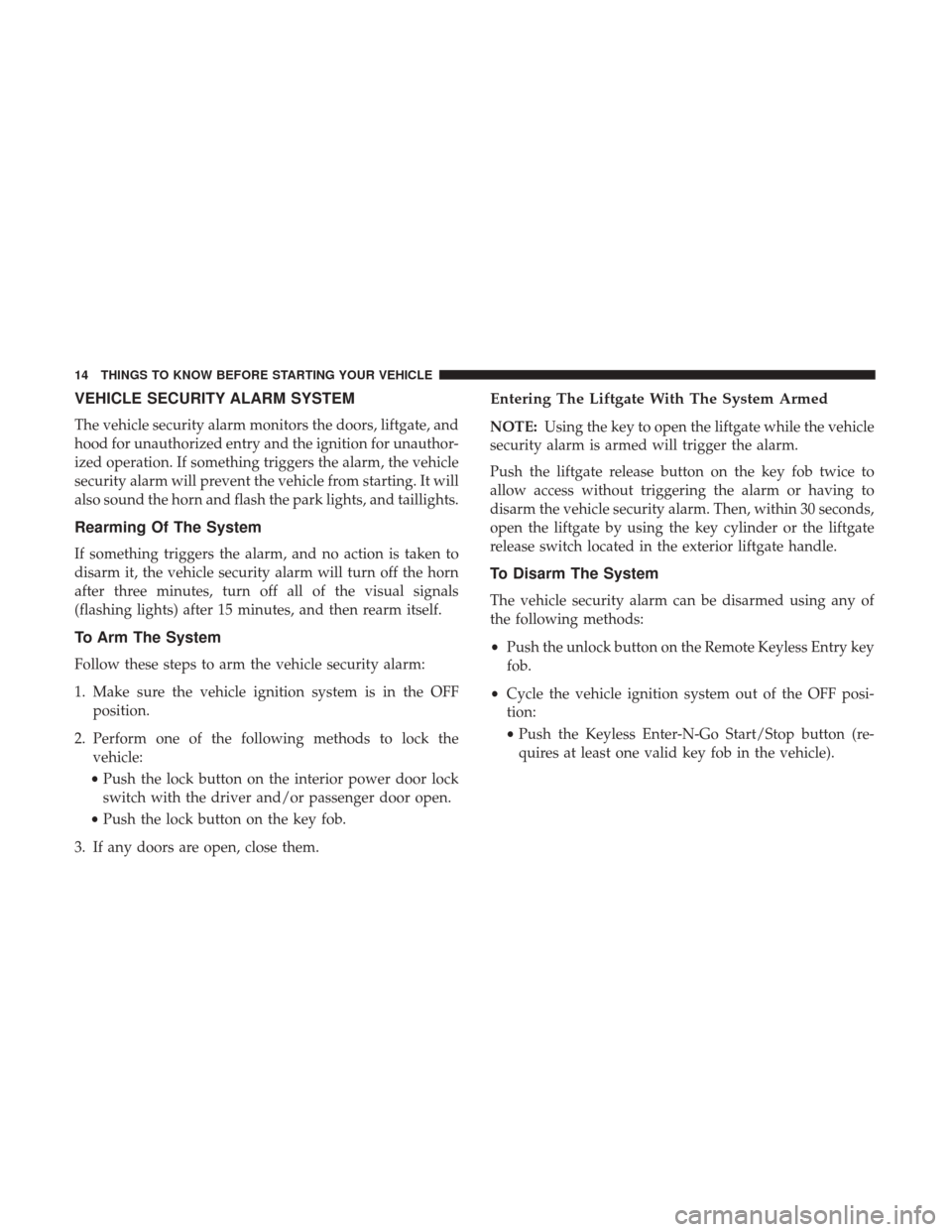
VEHICLE SECURITY ALARM SYSTEM
The vehicle security alarm monitors the doors, liftgate, and
hood for unauthorized entry and the ignition for unauthor-
ized operation. If something triggers the alarm, the vehicle
security alarm will prevent the vehicle from starting. It will
also sound the horn and flash the park lights, and taillights.
Rearming Of The System
If something triggers the alarm, and no action is taken to
disarm it, the vehicle security alarm will turn off the horn
after three minutes, turn off all of the visual signals
(flashing lights) after 15 minutes, and then rearm itself.
To Arm The System
Follow these steps to arm the vehicle security alarm:
1. Make sure the vehicle ignition system is in the OFFposition.
2. Perform one of the following methods to lock the vehicle:
• Push the lock button on the interior power door lock
switch with the driver and/or passenger door open.
• Push the lock button on the key fob.
3. If any doors are open, close them.
Entering The Liftgate With The System Armed
NOTE: Using the key to open the liftgate while the vehicle
security alarm is armed will trigger the alarm.
Push the liftgate release button on the key fob twice to
allow access without triggering the alarm or having to
disarm the vehicle security alarm. Then, within 30 seconds,
open the liftgate by using the key cylinder or the liftgate
release switch located in the exterior liftgate handle.
To Disarm The System
The vehicle security alarm can be disarmed using any of
the following methods:
• Push the unlock button on the Remote Keyless Entry key
fob.
• Cycle the vehicle ignition system out of the OFF posi-
tion:
• Push the Keyless Enter-N-Go Start/Stop button (re-
quires at least one valid key fob in the vehicle).
14 THINGS TO KNOW BEFORE STARTING YOUR VEHICLE
Page 83 of 329
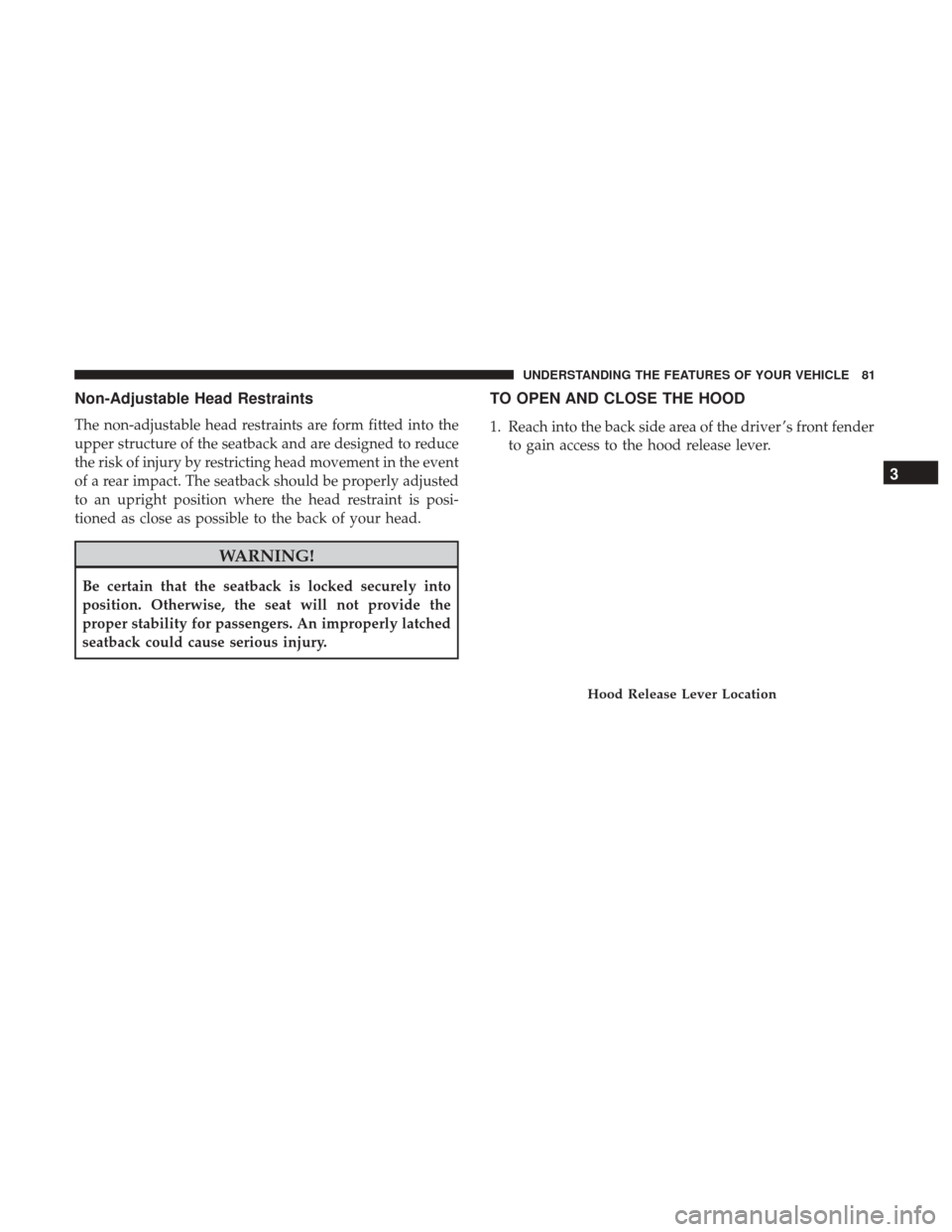
Non-Adjustable Head Restraints
The non-adjustable head restraints are form fitted into the
upper structure of the seatback and are designed to reduce
the risk of injury by restricting head movement in the event
of a rear impact. The seatback should be properly adjusted
to an upright position where the head restraint is posi-
tioned as close as possible to the back of your head.
WARNING!
Be certain that the seatback is locked securely into
position. Otherwise, the seat will not provide the
proper stability for passengers. An improperly latched
seatback could cause serious injury.
TO OPEN AND CLOSE THE HOOD
1. Reach into the back side area of the driver ’s front fenderto gain access to the hood release lever.
Hood Release Lever Location
3
UNDERSTANDING THE FEATURES OF YOUR VEHICLE 81
Page 84 of 329
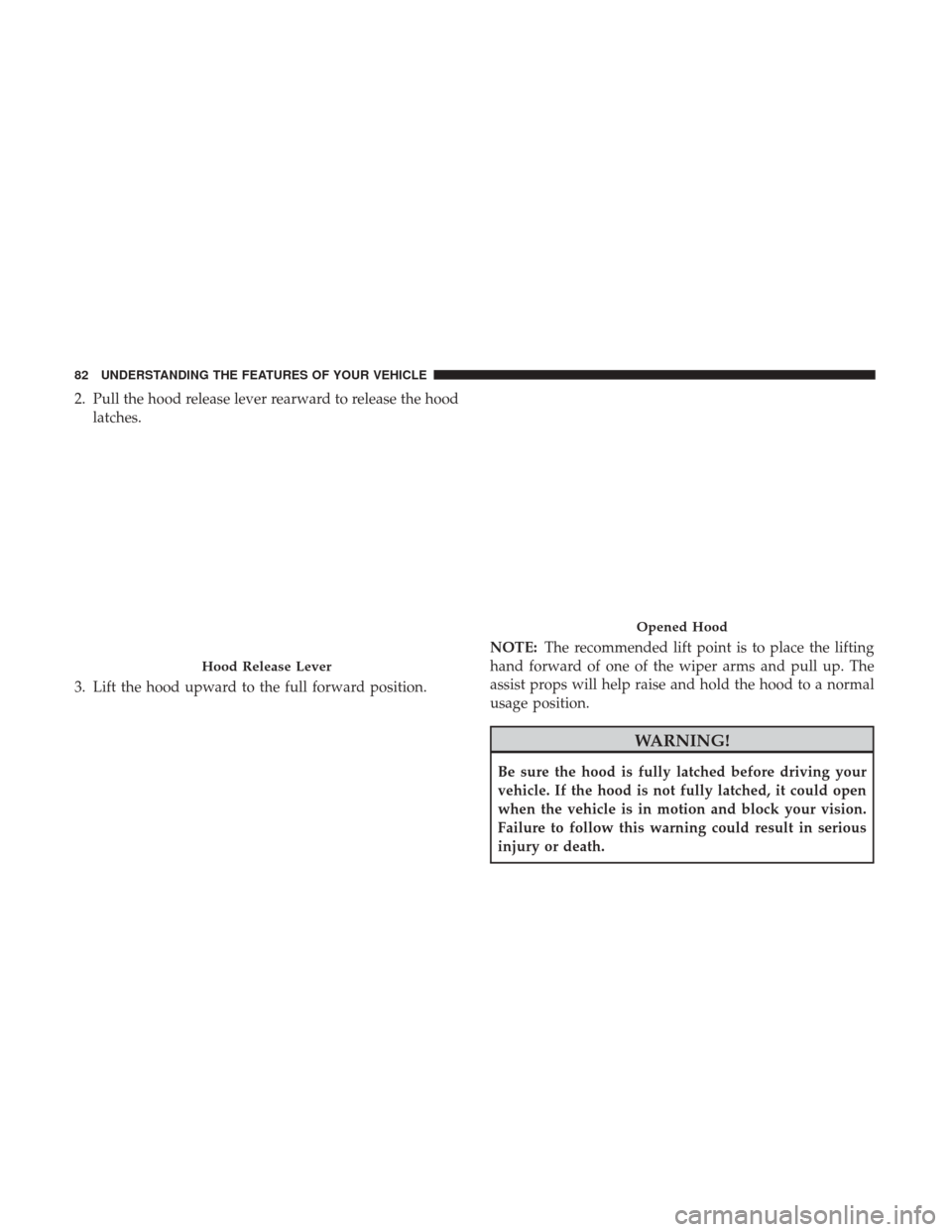
2. Pull the hood release lever rearward to release the hoodlatches.
3. Lift the hood upward to the full forward position. NOTE:
The recommended lift point is to place the lifting
hand forward of one of the wiper arms and pull up. The
assist props will help raise and hold the hood to a normal
usage position.
WARNING!
Be sure the hood is fully latched before driving your
vehicle. If the hood is not fully latched, it could open
when the vehicle is in motion and block your vision.
Failure to follow this warning could result in serious
injury or death.
Hood Release Lever
Opened Hood
82 UNDERSTANDING THE FEATURES OF YOUR VEHICLE
Page 258 of 329
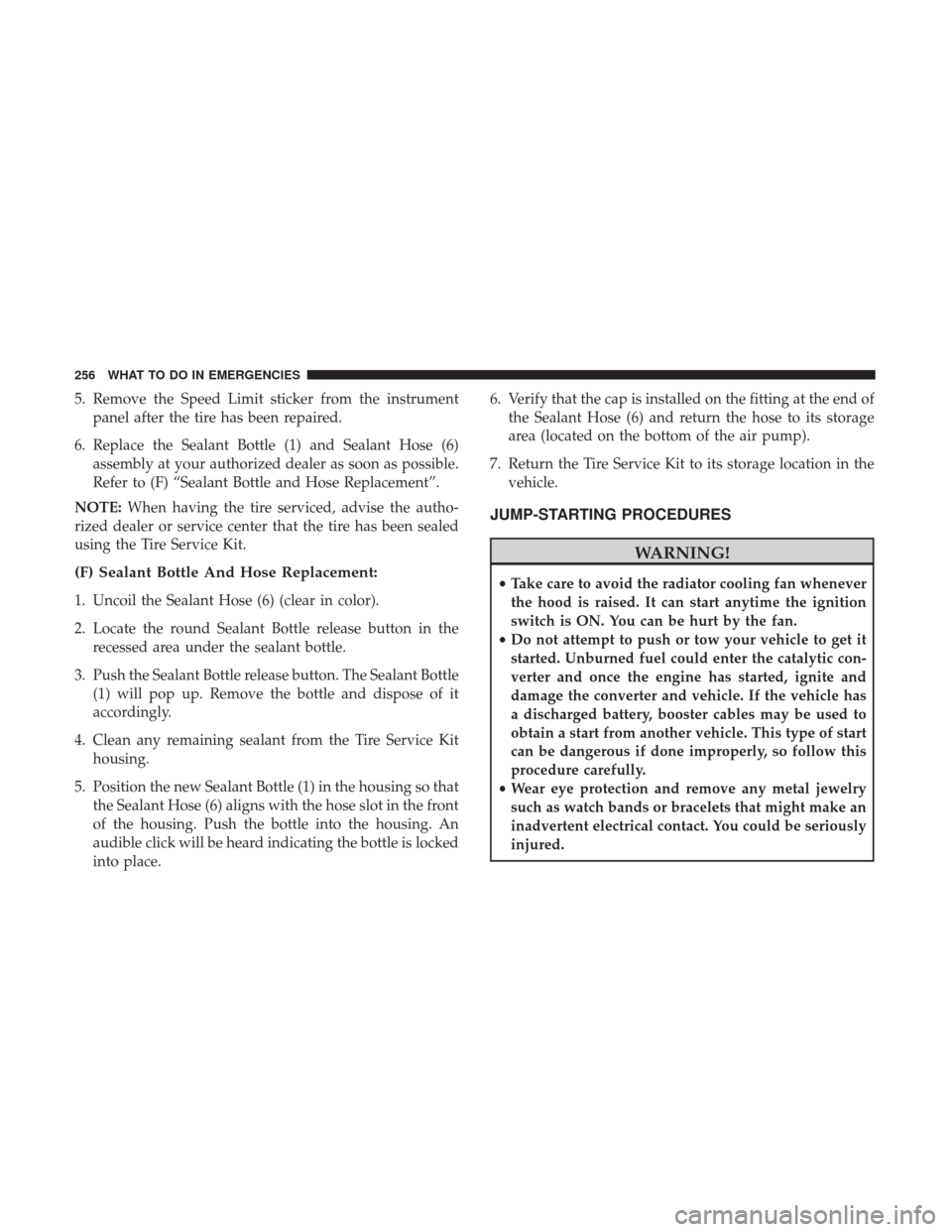
5. Remove the Speed Limit sticker from the instrumentpanel after the tire has been repaired.
6. Replace the Sealant Bottle (1) and Sealant Hose (6) assembly at your authorized dealer as soon as possible.
Refer to (F) “Sealant Bottle and Hose Replacement”.
NOTE: When having the tire serviced, advise the autho-
rized dealer or service center that the tire has been sealed
using the Tire Service Kit.
(F) Sealant Bottle And Hose Replacement:
1. Uncoil the Sealant Hose (6) (clear in color).
2. Locate the round Sealant Bottle release button in the recessed area under the sealant bottle.
3. Push the Sealant Bottle release button. The Sealant Bottle (1) will pop up. Remove the bottle and dispose of it
accordingly.
4. Clean any remaining sealant from the Tire Service Kit housing.
5. Position the new Sealant Bottle (1) in the housing so that the Sealant Hose (6) aligns with the hose slot in the front
of the housing. Push the bottle into the housing. An
audible click will be heard indicating the bottle is locked
into place. 6. Verify that the cap is installed on the fitting at the end of
the Sealant Hose (6) and return the hose to its storage
area (located on the bottom of the air pump).
7. Return the Tire Service Kit to its storage location in the vehicle.
JUMP-STARTING PROCEDURES
WARNING!
•Take care to avoid the radiator cooling fan whenever
the hood is raised. It can start anytime the ignition
switch is ON. You can be hurt by the fan.
• Do not attempt to push or tow your vehicle to get it
started. Unburned fuel could enter the catalytic con-
verter and once the engine has started, ignite and
damage the converter and vehicle. If the vehicle has
a discharged battery, booster cables may be used to
obtain a start from another vehicle. This type of start
can be dangerous if done improperly, so follow this
procedure carefully.
• Wear eye protection and remove any metal jewelry
such as watch bands or bracelets that might make an
inadvertent electrical contact. You could be seriously
injured.
256 WHAT TO DO IN EMERGENCIES
Page 274 of 329

WARNING!
•Use only refrigerants and compressor lubricants ap-
proved by the manufacturer for your air conditioning
system. Some unapproved refrigerants are flam-
mable and can explode, injuring you. Other unap-
proved refrigerants or lubricants can cause the sys-
tem to fail, requiring costly repairs. Refer to
Warranty Information Book, located on the DVD, for
further warranty information.
• The air conditioning system contains refrigerant un-
der high pressure. To avoid risk of personal injury or
damage to the system, adding refrigerant or any
repair requiring lines to be disconnected should be
done by an experienced technician.
CAUTION!
Do not use chemical flushes in your air conditioning
system as the chemicals can damage your air condition-
ing components. Such damage is not covered by the
New Vehicle Limited Warranty.
Refrigerant Recovery And Recycling
R-134a Air Conditioning Refrigerant is a hydrofluoro-
carbon (HFC) that is endorsed by the Environmental
Protection Agency and is an ozone-saving product. How-
ever, the manufacturer recommends that air conditioning
service be performed by authorized dealer or other service
facilities using recovery and recycling equipment.
NOTE: Use only manufacturer approved A/C system PAG
compressor oil and refrigerants.
Body Lubrication
Locks and all body pivot points, including such items as
seat tracks, door hinge pivot points and rollers, liftgate,
tailgate, decklid, sliding doors and hood hinges, should be
lubricated periodically with a lithium based grease, such as
MOPAR Spray White Lube to assure quiet, easy operation
and to protect against rust and wear. Prior to the applica-
tion of any lubricant, the parts concerned should be wiped
clean to remove dust and grit; after lubricating excess oil
and grease should be removed. Particular attention should
also be given to hood latching components to ensure
proper function. When performing other underhood ser-
vices, the hood latch, release mechanism and safety catch
should be cleaned and lubricated.
272 MAINTAINING YOUR VEHICLE
Page 320 of 329
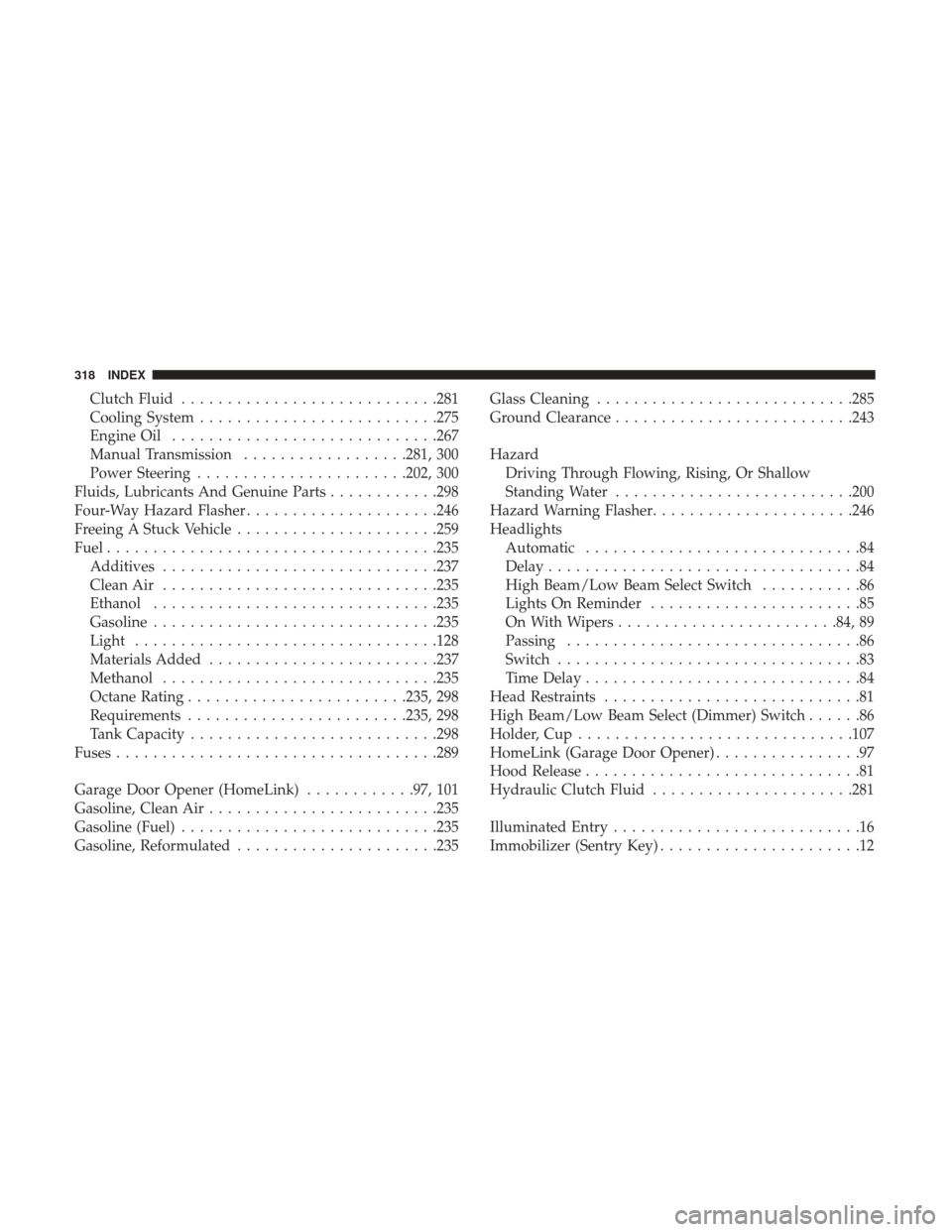
Clutch Fluid........................... .281
Cooling System ......................... .275
Engine Oil ............................ .267
Manual Transmission ..................281, 300
Power Steering ...................... .202, 300
Fluids, Lubricants And Genuine Parts ............298
Four-Way Hazard Flasher .....................246
Freeing A Stuck Vehicle ..................... .259
Fuel ................................... .235
Additives ............................. .237
Clean Air ............................. .235
Ethanol .............................. .235
Gasoline .............................. .235
Light ................................ .128
Materials Added ........................ .237
Methanol ............................. .235
Octane Rating ....................... .235, 298
Requirements ....................... .235, 298
Tank Capacity .......................... .298
Fuses .................................. .289
Garage Door Opener (HomeLink) ............97, 101
Gasoline, Clean Air ........................ .235
Gasoline (Fuel) ........................... .235
Gasoline, Reformulated ..................... .235Glass Cleaning
........................... .285
Ground Clearance ......................... .243
Hazard Driving Through Flowing, Rising, Or Shallow
Standing Water ......................... .200
Hazard Warning Flasher ..................... .246
Headlights Automatic ..............................84
Delay ..................................84
High Beam/Low Beam Select Switch ...........86
Lights On Reminder .......................85
On With Wipers ....................... .84, 89
Passing ................................86
Switch .................................83
Time Delay ..............................
84
Head Restraints ............................81
High Beam/Low Beam Select (Dimmer) Switch ......86
Holder, Cup ............................. .107
HomeLink (Garage Door Opener) ................97
Hood Release ..............................81
Hydraulic Clutch Fluid ..................... .281
Illuminated Entry ...........................16
Immobilizer (Sentry Key) ......................12
318 INDEX